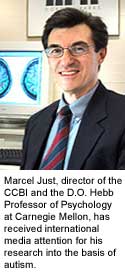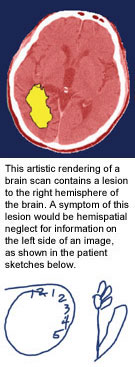What’s the difference between the brain and the mind?
How do humans understand language, perform calculations and form memories? Is there a source of thought and emotion that is separate from the physiological brain?

Thanks in large part to the pioneering work of Carnegie Mellon scientists, we now know where in the brain a specific thought or behavior comes from. In fact, they can watch thoughts occurring in real time, using functional magnetic resonance imaging (fMRI).
An fMRI measures brain activity. Through observation, scientists have determined that human thought has a biological basis that arises from the neural networks of the brain.
“Viewing the mind as a biological system helps us understand it enormously,” said Marcel Just, the D.O. Hebb Professor of Psychology and director of Carnegie Mellon’s Center for Cognitive Brain Imaging.
Using fMRI, Just can pinpoint which parts of the brain correspond to specific cognitive activities such as speech and memory. He can also map out the biological differences in people with neurological disorders. This past summer, Just revealed for the first time a biological basis for autism. Using fMRI scans, he found a deficiency in the coordination among brain areas in high-functioning autistics. This led to the underconnectivity theory, which holds that autism is a system-wide brain disorder that limits the coordination and integration among brain areas.
In their most recent study, Just and his colleagues found differences in the activation and synchronization of brain networks between people with autism and those without it. The results of the latest study also confirmed the underconnectivity theory, suggesting that possible treatments of autism might include instruction and training that focuses on the integration of the types of processing performed by different brain areas.

Ultimately, scientists expect that brain research will lead to better treatments for brain injuries and disorders. Psychology Professor Marlene Behrmann has used fMRI scans to learn what happens in the brain as a result of therapeutic interventions to mitigate the effects of brain damage. Her research focuses on visual perception—how the brain interprets what the eyes see—and she has studied the victims of stroke and brain injuries whose visual perception is impaired.
Behrmann and Just are members of the Center for the Neural Basis of Cognition, a joint Carnegie Mellon/University of Pittsburgh interdisciplinary research center where faculty employ multiple methods to explore the biological underpinnings of human thought. There still is much to learn, Behrmann said.
“We know about the biology, and we know about the behavior. And we don’t quite know how the behavior emerges from the really simplistic biological system,” she said.
Related Links:
Center for Cognitive Brain Imaging
A Biological Basis for Autism
Marlene Behrmann
Cognitive Neuroscience Lab
Center for the Neural Basis of Cognition



